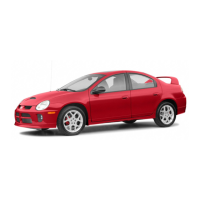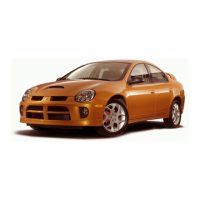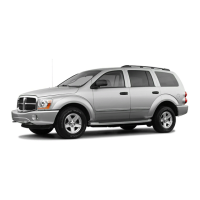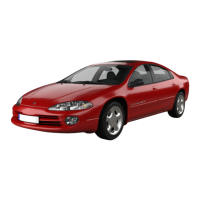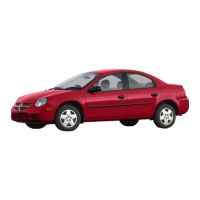a mounting bracket. The seat airbag module cannot
be repaired and must be replaced if deployed or in
any way damaged. When supplied with the proper
electrical signal the inflator seals the hole in the
airbag cushion so it can discharge the compressed
gas it contains directly into the cushion. Upon
deployment, the seat back trim cover will tear open
and allow the seat airbag to fully deploy between
the seat and the door.
NOTE: It will be necessary to remove the seat
back trim to gain access to the seat airbag
module connector when diagnosing the seat
airbag system.
WARNING: THE SEAT AIRBAG CONTAINS
ARGON GAS PRESSURIZED TO OVER 2500
PSI. DO NOT ATTEMPT TO DISMANTLE AN
AIRBAG MODULE OR TAMPER WITH ITS
INFLATOR. DO NOT PUNCTURE, INCINER-
ATE, OR BRING INTO CONTACT WITH
ELECTRICITY. DO NOT STORE AT TEMPERA-
TURE EXCEEDING 93°C (200°F). REPLACE
AIRBAG SYSTEM COMPONENTS ONLY WITH
PARTS SPECIFIED IN THE CHRYSLER
MOPAR PARTS CATALOG. SUBSTITUTE
PARTS MAY APPEAR INTERCHANGEABLE,
BUT INTERNAL DIFFERENCES MAY RESULT
IN INFERIOR OCCUPANT PROTECTION. THE
FASTENERS, SCREWS, AND BOLTS ORIGI-
NALLY USED FOR THE AIRBAG SYSTEM
COMPONENTS HAVE SPECIAL COATINGS
AND ARE SPECIFICALLY DESIGNED FOR
THE AIRBAG SYSTEM. THEY MUST NEVER
BE REPLACED WITH ANY SUBSTITUTES.
ANY TIME A NEW FASTENER IS NEEDED,
REPLACE IT WITH THE CORRECT FASTEN-
ERS PROVIDED IN THE SERVICE PACKAGE
OR SPECIFIED IN THE CHRYSLER MOPAR
PARTS CATALOG. FAILURE TO TAKE THE
PROPER PRECAUTIONS COULD RESULT IN
ACCIDENTAL AIRBAG DEPLOYMENT AND
PERSONAL INJURY OR DEATH.
3.1.6 SPECIAL TOOLS
Some airbag diagnostic tests use special tools,
8310 and 8443 airbag load tool, for testing squib
circuits. The load tools contain fixed resistive loads,
jumpers and adapters. The fixed loads are con-
nected to cables and mounted in a storage case. The
cables can be directly connected to some airbag
system connectors. Jumpers are used to convert the
load tool cable connectors to the other airbag sys-
tem connectors. The adapters are connected to the
module harness connector to open shorting clips
and protect the connector terminal during testing.
When using the load tool follow all of the safety
procedures in the service information for discon-
necting airbag system components. Inspect the wir-
ing, connector and terminals for damage or mis-
alignment. Substitute the airbag load tool in place
of a Driver or Passenger Airbag, curtain airbag,
clockspring, or seat belt tensioner (use a jumper if
needed). Then follow all of the safety procedures in
the service information for connecting airbag sys-
tem components. Read the module active DTC’s. If
the module reports NOACTIVEDTC’s the defective
component has been removed from the system and
should be replaced. If the DTC is still active, con-
tinue this process until all components in the circuit
have been tested. Then disconnect the module con-
nector and connect the matching adapter to the
module connector. With all airbags disconnected
and the adapter installed the squib wiring can be
tested for open and shorted conditions.
3.1.7 DIAGNOSTIC TROUBLE CODES
Airbag diagnostic trouble codes consist of active
and stored codes. If more than one code exists,
diagnostic priority should be given to the active
codes.
Each diagnostic trouble code is diagnosed by
following a specific testing procedure. The diagnos-
tic test procedures contain step-by-step instructions
for determining the cause of the trouble codes. It is
not necessary to perform all of the tests in this book
to diagnose an individual code.
Active diagnostic trouble codes for the airbag
system are not permanent and will change the
moment the reason for the code is corrected. In
certain test procedures within this manual, diag-
nostic trouble codes are used as a diagnostic tool.
3.1.7.1 ACTIVE CODES
The code becomes active as soon as the malfunc-
tion is detected or key-off, whichever occurs first.
An active trouble code indicates an on-going mal-
function. This means that the malfunction is cur-
rently there every time the control module checks
that circuit/function. It is impossible to erase an
active code; active codes automatically erase by
themselves when the reason for the code has been
corrected.
With the exception of the warning lamp trouble
codes or malfunctions, when a malfunction is de-
tected, the airbag lamp remains lit for a minimum
of 12 seconds or as long as the malfunction is
present.
An “Interrogate Right SIACM or Interrogate left
SIACM” diagnostic trouble code indicates an active
trouble code in the respective module.
4
GENERAL INFORMATION
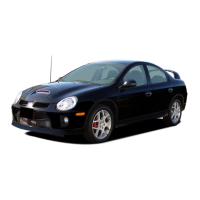
